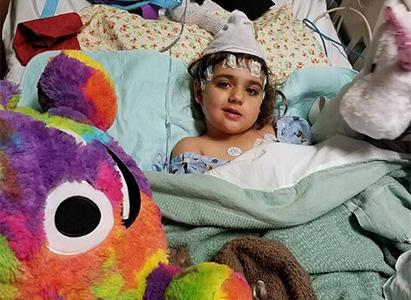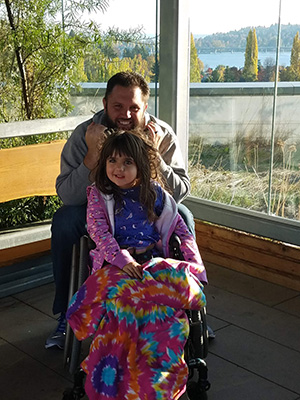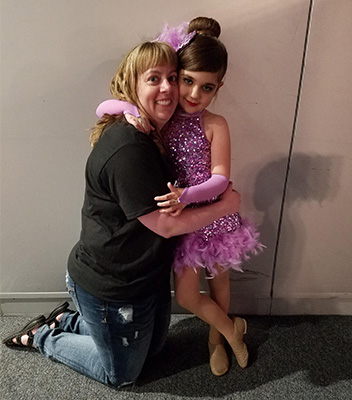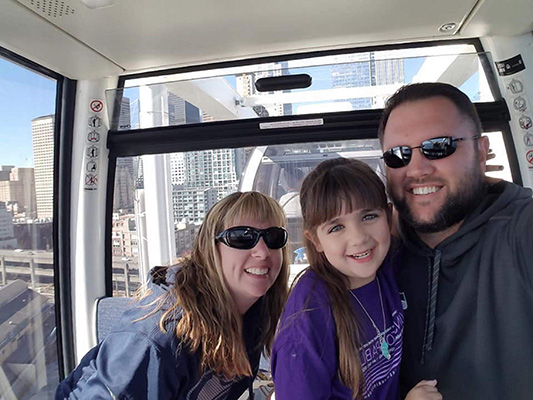Makenzie Dances Again After Pediatric Stroke
 Makenzie Childs, 6, has returned to doing what she loves most – competitive dance – following a stroke in October 2017.
Makenzie Childs, 6, has returned to doing what she loves most – competitive dance – following a stroke in October 2017.
The lopsided smile on Makenzie’s face said it all. She had just thrown up, and her dad, Shawn Childs, was helping her get cleaned up in the bathtub. “My husband yelled for me to come into the bathroom and then asked Makenzie to smile,” Jamie Childs, Makenzie’s mom, said. “The smile was devastating. It was only the right half of her face. I knew something wasn’t right.”
Makenzie’s mysterious illness began earlier that day when she fell while playing in a corn maze with her grandparents. She became inconsolable, not wanting to stand, so her grandparents decided to take her home. On the drive home, she got car sick. “She told them she didn’t feel well and went to lie down as soon as they got home,” Shawn said. “When I got home from work, she was still sleeping.” Concerned she might be getting sick, her parents took her to a local urgent care near their home in Spanaway, Washington later that night. After running through her vitals and having her walk up and down the hallway, the doctor told Shawn and Jamie he suspected that Makenzie had a minor concussion. Rest would help. She should feel better in the morning. In the 20 minutes it took the Childs to drive home from the urgent care, Makenzie’s health went downhill quickly. Suddenly, Makenzie seemed uncoordinated. She was unable to pick up her feet to go up or down stairs. She couldn’t take her shoes off. Then, she got sick to her stomach for the second time that day, leading to the unforgettable smile in the bathtub. As soon as her parents saw how the left side of her face was drooping, they dropped everything and rushed Mackenzie to the Emergency Department at Mary Bridge. There, the Childs were told it could be one of three things – epilepsy, a migraine or a stroke. “I turned to my sister who was at the hospital with us and asked, “Did she say stroke?” Jamie said. “We had never heard of a child getting a stroke.”
From surprising diagnosis, a blessing emerges
 Several tests later, a neurologist confirmed that Makenzie had suffered a stroke. The Childs remember the doctor telling them the damage was irreversible. “All I could think of at the time is that my little girl, my little bundle of energy, would never be the same,” Jamie said. Makenzie’s team at Mary Bridge ultimately decided her rehab would be best managed by Seattle Children’s comprehensive program, and the family made plans to transfer Makenzie to Seattle. Pediatric stroke specialist, Dr. Catherine Amlie-Lefond, director of Seattle Children’s Pediatric Vascular Neurology Program, was brought in to review her case. “That was our biggest blessing. To have Dr. Amlie-Lefond taking care of our daughter is a great gift,” said Jamie. “She sat down and explained Makenzie’s exact stroke to us. She drew pictures and talked with us in a way that made us understand how significant this was but how optimistic we should be that Makenzie could recover.” Once at Seattle Children’s, Makenzie immediately began intensive rehabilitation in the hospital. Her recovery would involve weeks of physical, occupational and speech therapy to relearn the movements and functions she had lost due to the stroke.
Several tests later, a neurologist confirmed that Makenzie had suffered a stroke. The Childs remember the doctor telling them the damage was irreversible. “All I could think of at the time is that my little girl, my little bundle of energy, would never be the same,” Jamie said. Makenzie’s team at Mary Bridge ultimately decided her rehab would be best managed by Seattle Children’s comprehensive program, and the family made plans to transfer Makenzie to Seattle. Pediatric stroke specialist, Dr. Catherine Amlie-Lefond, director of Seattle Children’s Pediatric Vascular Neurology Program, was brought in to review her case. “That was our biggest blessing. To have Dr. Amlie-Lefond taking care of our daughter is a great gift,” said Jamie. “She sat down and explained Makenzie’s exact stroke to us. She drew pictures and talked with us in a way that made us understand how significant this was but how optimistic we should be that Makenzie could recover.” Once at Seattle Children’s, Makenzie immediately began intensive rehabilitation in the hospital. Her recovery would involve weeks of physical, occupational and speech therapy to relearn the movements and functions she had lost due to the stroke.
Stroke can happen at any age
 Though pediatric stroke is rare, it occurs more frequently than one may think. “Stroke is as common as brain tumors in children, yet many people are surprised to learn that stroke can happen in children at any age,” Amlie-Lefond said. After reviewing Makenzie’s case, Amlie-Lefond determined Makenzie’s stroke was caused by focal cerebral arteriopathy, a condition that typically occurs in a previously healthy child. Stroke occurs in patients with focal cerebral arteriopathy, when one of the main arteries to the brain narrows, causing a clot, or thrombus, to form. “This cause of stroke is unique to children,” Amlie-Lefond said. “Focal cerebral arteriopathy is linked to inflammation or the presence of a virus in the brain, so we monitor these children very closely.” Amlie-Lefond started Makenzie on a daily aspirin to prevent a secondary stroke once she didn’t see any signs of the arteriopathy progressing. “Apart from her daily aspirin, Makenzie didn’t take any other medication,” said Shawn. “Dr. Amlie-Lefond explained that because there wasn’t a disease that caused the stroke, there was no disease to treat other than getting her the physical, occupational and speech therapy she needed to recover.”
Though pediatric stroke is rare, it occurs more frequently than one may think. “Stroke is as common as brain tumors in children, yet many people are surprised to learn that stroke can happen in children at any age,” Amlie-Lefond said. After reviewing Makenzie’s case, Amlie-Lefond determined Makenzie’s stroke was caused by focal cerebral arteriopathy, a condition that typically occurs in a previously healthy child. Stroke occurs in patients with focal cerebral arteriopathy, when one of the main arteries to the brain narrows, causing a clot, or thrombus, to form. “This cause of stroke is unique to children,” Amlie-Lefond said. “Focal cerebral arteriopathy is linked to inflammation or the presence of a virus in the brain, so we monitor these children very closely.” Amlie-Lefond started Makenzie on a daily aspirin to prevent a secondary stroke once she didn’t see any signs of the arteriopathy progressing. “Apart from her daily aspirin, Makenzie didn’t take any other medication,” said Shawn. “Dr. Amlie-Lefond explained that because there wasn’t a disease that caused the stroke, there was no disease to treat other than getting her the physical, occupational and speech therapy she needed to recover.”
Finding strength and balance
 Makenzie made huge strides in therapy. As a competitive dancer, Makenzie was driven to regain her strength, balance and coordination. “She wanted to get back to her dance buddies more than anything,” Jamie said. “She always had visitors from her dance team. On more than one occasion we had to close the door to her room, so they could carry on with their private dance party.” Within weeks, doctors gave Makenzie the green light to go home. Today, almost two years after her stroke, Makenzie is back to dance and even takes Pilates to help build her core strength. She recently competed with her dance team at a national competition, helping them take third place overall. “We are big believers that you can’t let the diagnosis determine the dreams of your child,” Jamie said. The brace Makenzie wears on her left leg and her left hand are the only remaining physical clues of her stroke. “Children have a remarkable ability to recover and Makenzie’s a remarkable kid,” Amlie-Lefond said. “She has creative parents who helped her set a goal to get her back to her favorite activities and then figured out how to make it fun for her.”
Makenzie made huge strides in therapy. As a competitive dancer, Makenzie was driven to regain her strength, balance and coordination. “She wanted to get back to her dance buddies more than anything,” Jamie said. “She always had visitors from her dance team. On more than one occasion we had to close the door to her room, so they could carry on with their private dance party.” Within weeks, doctors gave Makenzie the green light to go home. Today, almost two years after her stroke, Makenzie is back to dance and even takes Pilates to help build her core strength. She recently competed with her dance team at a national competition, helping them take third place overall. “We are big believers that you can’t let the diagnosis determine the dreams of your child,” Jamie said. The brace Makenzie wears on her left leg and her left hand are the only remaining physical clues of her stroke. “Children have a remarkable ability to recover and Makenzie’s a remarkable kid,” Amlie-Lefond said. “She has creative parents who helped her set a goal to get her back to her favorite activities and then figured out how to make it fun for her.”
Helping others by raising awareness
 Jamie and Shawn recently had the opportunity to speak to other families of pediatric stroke survivors at the 2019 Pediatric Stroke Warriors Wishes Gala. They are thankful for the support communities like Pediatric Stroke Warriors offered them when they felt alone and frustrated after Makenzie’s diagnosis. “We learned that we were not alone, that we were not the only family dealing with this,” Jamie said. “That was the most healing part of our journey. We found a whole group of parents, siblings, and other survivors that understood the challenges and lifted us up when we needed it most.” The Childs also want to help educate other families about pediatric stroke. Jamie encourages others to learn the signs and symptoms of stroke in children. “The more we learned about pediatric stroke, the more Makenzie gave us the inspiration that this is way bigger than us,” she said. “If we can help another family, then we believe we can make a difference.”
Jamie and Shawn recently had the opportunity to speak to other families of pediatric stroke survivors at the 2019 Pediatric Stroke Warriors Wishes Gala. They are thankful for the support communities like Pediatric Stroke Warriors offered them when they felt alone and frustrated after Makenzie’s diagnosis. “We learned that we were not alone, that we were not the only family dealing with this,” Jamie said. “That was the most healing part of our journey. We found a whole group of parents, siblings, and other survivors that understood the challenges and lifted us up when we needed it most.” The Childs also want to help educate other families about pediatric stroke. Jamie encourages others to learn the signs and symptoms of stroke in children. “The more we learned about pediatric stroke, the more Makenzie gave us the inspiration that this is way bigger than us,” she said. “If we can help another family, then we believe we can make a difference.”
Resources
Published in On the Pulse blog, May 29, 2019